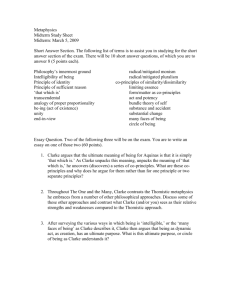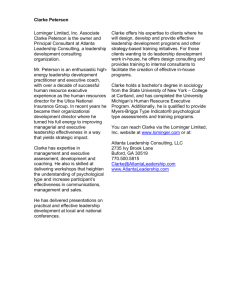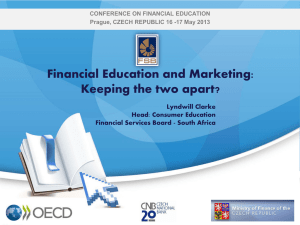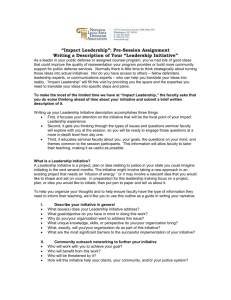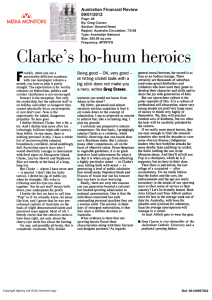Netconsumers
advertisement
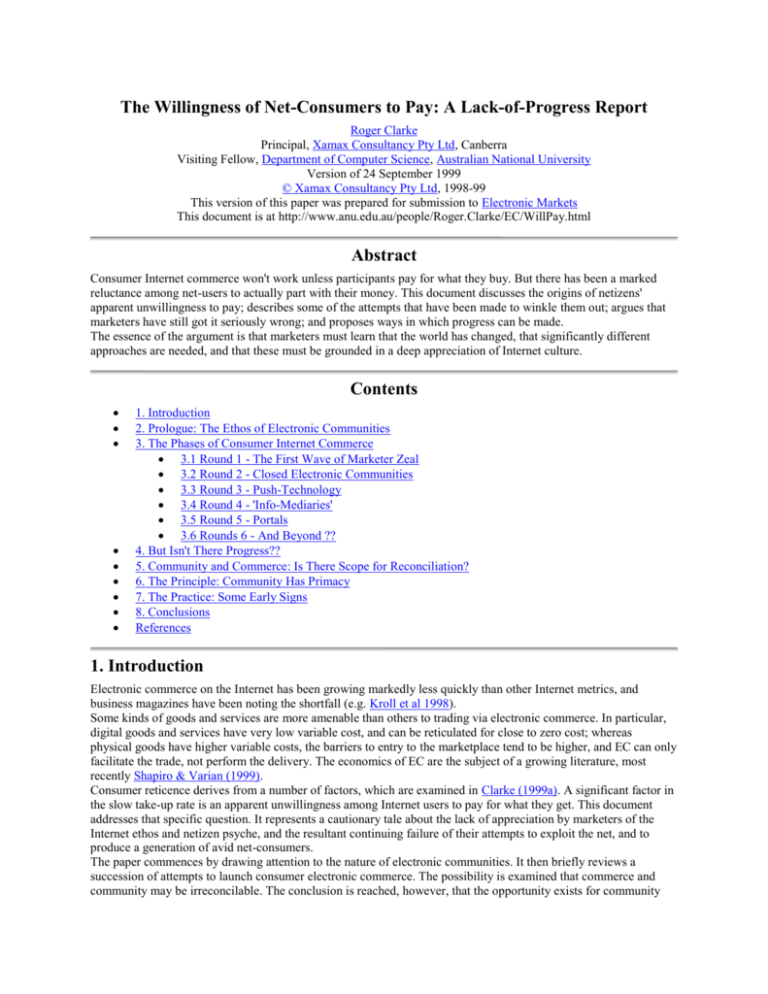
The Willingness of Net-Consumers to Pay: A Lack-of-Progress Report Roger Clarke Principal, Xamax Consultancy Pty Ltd, Canberra Visiting Fellow, Department of Computer Science, Australian National University Version of 24 September 1999 © Xamax Consultancy Pty Ltd, 1998-99 This version of this paper was prepared for submission to Electronic Markets This document is at http://www.anu.edu.au/people/Roger.Clarke/EC/WillPay.html Abstract Consumer Internet commerce won't work unless participants pay for what they buy. But there has been a marked reluctance among net-users to actually part with their money. This document discusses the origins of netizens' apparent unwillingness to pay; describes some of the attempts that have been made to winkle them out; argues that marketers have still got it seriously wrong; and proposes ways in which progress can be made. The essence of the argument is that marketers must learn that the world has changed, that significantly different approaches are needed, and that these must be grounded in a deep appreciation of Internet culture. Contents 1. Introduction 2. Prologue: The Ethos of Electronic Communities 3. The Phases of Consumer Internet Commerce 3.1 Round 1 - The First Wave of Marketer Zeal 3.2 Round 2 - Closed Electronic Communities 3.3 Round 3 - Push-Technology 3.4 Round 4 - 'Info-Mediaries' 3.5 Round 5 - Portals 3.6 Rounds 6 - And Beyond ?? 4. But Isn't There Progress?? 5. Community and Commerce: Is There Scope for Reconciliation? 6. The Principle: Community Has Primacy 7. The Practice: Some Early Signs 8. Conclusions References 1. Introduction Electronic commerce on the Internet has been growing markedly less quickly than other Internet metrics, and business magazines have been noting the shortfall (e.g. Kroll et al 1998). Some kinds of goods and services are more amenable than others to trading via electronic commerce. In particular, digital goods and services have very low variable cost, and can be reticulated for close to zero cost; whereas physical goods have higher variable costs, the barriers to entry to the marketplace tend to be higher, and EC can only facilitate the trade, not perform the delivery. The economics of EC are the subject of a growing literature, most recently Shapiro & Varian (1999). Consumer reticence derives from a number of factors, which are examined in Clarke (1999a). A significant factor in the slow take-up rate is an apparent unwillingness among Internet users to pay for what they get. This document addresses that specific question. It represents a cautionary tale about the lack of appreciation by marketers of the Internet ethos and netizen psyche, and the resultant continuing failure of their attempts to exploit the net, and to produce a generation of avid net-consumers. The paper commences by drawing attention to the nature of electronic communities. It then briefly reviews a succession of attempts to launch consumer electronic commerce. The possibility is examined that commerce and community may be irreconcilable. The conclusion is reached, however, that the opportunity exists for community and commerce to co-exist, if only marketers are prepared to recognise and adapt themselves to the tenets that underlie the operation of the virtual world. 2. Prologue: The Ethos of Electronic Communities On the original Internet, the users were members of research communities, whose pattern of behaviour was to share effort. No thought was given to the idea that data and services might be worth charging for. Similarly, the bulletinboard and newsgroups users who migrated onto the Internet had concepts of community-service and sharing, but no developed notion of an economy. The newcomers during the early period of growth, roughly 1990-94, cheerfully adopted this ethos. The psychology of individual behaviour within electronic communities is considered in Hauben & Hauben (1997). The 'virtual community' was originally thought of as a social construct, for social purposes, both in the pioneer research communities (Clarke 1994a) and in communities more generally (Rheingold 1994). Electronic communities are considered in various papers indexed at Clarke (1995-). Key aspects of the culture are egalitarianism and openness. In many fora, this manifests itself as direct speech, 'sounding off', and flaming. Some communities have, however, harnessed the opportunity to conduct more polite and constructive interactions. Physical communities are based primarily on physical proximity. Within a geographical area, whose size is determined by the available transport and communications technologies, sub-communities arise whose members share a common interest or belief-system. Virtual communities, on the other hand, are seldom based on physical proximity alone, but almost always on some kind of common interest. They extend over unlimited physical space, and enable people to 'meet' and communicate who would not otherwise even be likely to know of one another's existence. Rheingold has speculated that their attraction has partly been as a result of the breakdown of older forms of neighbourhood, community and culture. The impacts of the Internet's geographical reach, trumpeted as 'the death of the tyrrany of distance', is leading to such unexpected outcomes as the re-uniting of the diasporas of many cultures, and the opportunity for survival of dying languages. In their enthusiasm, many commentators have overlooked the fact that location still matters. After the euphoria is over, a new balance will have arisen between physical and virtual behaviour, at both individual and social levels. This brief introduction to the notion of electronic community has set the scene for a review of the consumer electronic commerce initiatives that have been launched during the Web's first few years. 3. The Phases of Consumer Internet Commerce This section provides an assessment of the patterns of marketer and consumer behaviour that have been apparent during the first waves of consumer commerce on the Internet. 3.1 Round 1 - The First Wave of Marketer Zeal The Internet has gone through a succession of phases during its 30-year history (e.g. ISOC 1999). In Australia, it has been a professionally-managed service for the whole of the 1990s. At first, access was limited to researchers, but it has been available to the broader community since about 1992-93 (Clarke 1998d). 'Entrepreneurs' came late to the Internet, and corporations even later, 25 years after its emergence, around 1995 (Hotwired claims to have launched the first serious commercial site, in October 1994). The trigger was the emergence of the World Wide Web, which for the first time created a framework within which media other than text could become mainstream. The early movers from the business community perceived the Web as a new medium for advertising, with the additional attraction of enabling interaction with the consumer. Schrage (1994) heralded the arrival of business in cyberspace, pooh-hooing the 'techno-wonks', and trumpeting that "the economics of advertising, promotion and sponsorship ... will shape the virtual realities we may soon inhabit ... Cyberspace's commercial future is inevitable. There will be billboards along the Information Superhighway". He co-opted David Brin's fictional (1990) 'courtesy worm', EmilyPost (an application of virus technology to calm down inveterate 'flamers', and hence a creature of electronic community), in order to invent the notion of advertising viruses that would insinuate themselves into images and programs. Business regarded the community-service notion as childish. They perceived that costs could not remain hidden and absorbed, and that revenue-collection had to become more overt. A margin was available (and, where monopoly conditions could be achieved, a very large margin). Where market-dominance and barriers to entry could be established, long-term super-profits were a real possibility. In short, conventional business models were to be applied to the net. On-line services were to enable marketers to achieve 'one-to-one relationships' with individual consumers (Peppers & Rogers 1993). This fitted well with trends in manufacturing, in which the market as a whole could be economically addressed as a large number of micro-markets: hence 'mass micro-marketing' and 'mass customisation' (Pine 1992). The investments made in electronic marketing proved to be anything but 'patient money', however. Little over 12 months after Hotwired's launch, another Wired author wrote of 'The Great Web Wipeout', with such heralded new businesses as The Spot, The New York Times site, and Hotwired already licking their wounds (Bayers 1996). The failures were ascribed to overload on the commercial web-site servers and the Internet backbones, limited marketer-value in the hits, and limited revenues from advertisers. In little more than an aside, Bayers noted that "the death of commercial publishing on the Web doesn't mean the death of the Web itself ... [as] more than 30 million personal, noncommercial home pages ... continue to spread like kudzu. ... [People] will do what they've always [sic] done: communicate with friends, meet people from around the world and create a culture now approaching its fourth decade of existence". 3.2 Round 2 - Closed Electronic Communities The era of public bulletin-board services (BBS) (e.g. Rickard 1993) and The Well (Rheingold 1994, Hafner 1997) had spawned proprietary on-line services, like The Source, Prodigy (Shapiro 1993), CompuServe, GEnie and Apple eWorld. As the Web exploded around 1993-95, the Internet proved to be a serious challenge to these businesses (e.g. Wolfe 1994). One business that detected the sea-change (just) in time was America Online (AOL). During the mid-1990s, AOL abandoned its proprietary protocols, and began advertising using the slogan "AOL is the Internet and a whole lot more". It managed to bring its customer-base with it, and subsequently achieved a substantial growth-rate. This stimulated replicators, most notably Microsoft (Nollinger 1995). One of the challenges, however, is to provide a genuine differentiation: "One of the more curious things about AOL's brands is that most of them are as readily available on the Web as on AOL itself" (Rose 1996). It appears that a substantial amount of AOL's revenue may be from connect-time for chat-sessions. Apart from some die-hards, this is a substantially ephemeral experience for newcomers, and hence a niche to be exploited, rather than the basis of a long-term business case. AOL uses contrivances, such as restrictions on browser capabilities, to limit access by its 'members' to the Internet, and to sustain the myth that AOL is a closed 'community'. Whether the company can continue to be a free rider on the work of others, and to play on the ignorance of newcomers to the net, remains to be seen. Successive attempts by Microsoft variously to take over the Internet, to create a closed segment of the Internet, or to create a parallel service, met dismal failure. It launched Microsoft Network (MSN) as a competitor to the public Internet, in early 1995. By December 1995, it was forced into a complete strategic about-face, which involved building Internet access into Microsoft's entire existing suite of products, from applications to tools to servers. Soon afterwards, Microsoft announced the abandonment of the proprietary version of MSN, in favour of the Web's nonproprietary HTML standards (Caruso 1996). Subsequently, mis-fires have included Slate (which, almost alone among the once-heralded commercial web-zines, at least survives, due to a generous corporate benefactor, and respectable subscriptions and traffic), and Sidewalk (Romano 1998). By early 1998, some commentators were speculating that Microsoft's strategic focus might be shifting away from the Internet, towards television (Rose 1998). 3.3 Round 3 - Push-Technology Marketers are used to working with broadcast media, and passive consumers. They were non-plussed by the predominantly demand-pull mode of Internet services. They accordingly set out to replace pull with pushtechnologies. Products such as PointCast and Castanet were devised to reverse (or subvert) the World Wide Web, and utilise opportunities like screen-savers and browser window-margins to place compelling content in front of users, and unleash the consumer-tiger inside each of them. The terms used to describe such approaches reflected the marketer's obsession with broadcast at consumers, rather than communications linkages with people: 'push-technology', 'webcasting' and 'Internet broadcasting' via 'channels'. It is "a data distribution model in which selected data is automatically delivered into the user's computer at prescribed intervals or based on some event that occurs" (Iatek). Perhaps the most extreme, celebratory rendition was that by Wired Magazine's Kelly & Wolf (1997). It generated sceptical response. Implementations of the push model include: the original experiments in applying the Internet to audio- and video-broadcasting, which went under the title MBone (short for Multicast Backbone); PointCast, which was designed to push selected news and stock quotes into a user's machine at prescribed intervals; Marimba's Castanet. Here is Castanet's own summary of why Castanet is good for the enterprise; and Netscape's NetCaster (which was originally launched as Constellation). These new push-technologies are of course applicable to much more than marketing (in the same way that the longstanding push-technologies of mail, fax, the telephone and email have multiple applications). Moreover, there is no doubt that some applications of push-technologies will be highly valued, by consumers as well as by marketers. On the other hand, there were impediments. One challenge confronting the proponents of push-technology was the dramatic leap in bandwidth needed to support experience-rich formats like high-quality images, animation and video. In addition, from the very beginning, there were serious concerns among consumers as to whether such services would harm the web, and the Internet as a whole, and be a vehicle for further impositions by marketers on consumers. Within a mere 12 months, Wired Magazine had seen the light: "The most surprising roadblock for push ... comes not from technology, but from the intended audience. Push media's promises are often met with outright resentment from computer owners glad to be free of TV's broadcast model. ... Consumers are smarter than media organisations thought" (Boutin 1998). The much-heralded push-technologies are surviving in niches; but as far as the mainstream market is concerned, push-technology has gone very quiet. 3.4 Round 4 - 'Info-Mediaries' A movement during 1996-98, associated with John Hagel (Hagel & Rayport 1996, Hagel & Armstrong 1997, Hagel & Singer 1999), sought to apply (or subvert or capture) the concept of 'electronic community', and use it as a means of accelerating consumer adoption of electronic commerce. The 'Net Gain' thesis was that the Internet is giving rise to a new model of consumer-supplier interaction, which they called 'the virtual community business model'. In particular, they perceived a shift in market power to 'info-mediaries', whose primary affinity needed to be to consumer-members. The engine underpinning this new order of things was to be information capture, to support profiling of both consumers and suppliers. The catch-phrase was 'community before commerce', although it sounded more like 'commerce exploiting community'. Reflecting that perspective, Browning & Reiss (1998), in their 'Encyclopedia of the New Economy' define 'community' as 'aggregated people', whose homogeneity gives tham "immense (though still mainly potential) economic clout". By the third quarter of 1998, the wheels were falling off this movement (e.g. Futrelle 1998). The exploitation of electronic community by electronic commerce was showing little sign of success: the supposed dominance of economic interests over social concerns was being thrown into serious doubt. The slow take-up of the info-mediaries notion was entirely consistent with the disappointing outcomes from a variety interesting initiatives. In the electronic payments arena, for example, PCs still don't come with smart cardreaders as standard equipment; chip-based SVCs continue to be piloted with limited success; Mondex in particular is making little headway; SET is stalling; and in October 1998, the great hope for e-cash, Digicash, had filed for Chapter 11 bankruptcy protection, with a long hiatus before the eventual sale of the intellectual property in the third quarter of 1999. Yet these warning signs continued to be overlooked by inveterately optimistic marketers. 3.5 Round 5 - Portals In the third quarter of 1998, a new round of marketing fervour swept into vogue. The conventional wisdom during the second half of 1998 was that 'portals' would be the means whereby corporations would capture the hearts and minds of consumers. A portal is meant to be the automatic first-port-of-call for large numbers of captive net-users who are eager to part with their money. They were therefore expected by this particular round of soothsayers to command high advertising-rates and click-through fees, plus commissions on resulting sales (Nee 1998). Key services that such portals can offer are argued to be free email, plus personalised launch-pages, with automated page-change notification and news customisation (Thornberry 1998). Existing sites that are regularly invoked are Yahoo!, AOL, Netscape, Excite, Lycos, CNet, Hotwired - Hotbot, Microsoft's multiple successive (and mostly failed) ventures, and some of Microsoft's acquisitions such as Hotmail. Newcomer 'wannabees' that rate mention include Disney - Infoseek, NBC- Snap and Liberty Media. Scope is perceived for niche players, especially those leveraging off a substantial customer-base, such as David Bowie. The notion of 'portal' has staggered along as an 'idea in good standing' well into 1999. If investors had cared to listen, its demise had been portended within days of its invention. Industry comnmentator, Guy Kawasaki was widely quoted as having quickly defined a portal as "a hole in the Internet that shareholders pour money into". 3.6 Rounds 6 - And Beyond ?? It appears likely that, yet again in the year 2000, some new consultant will achieve a web-year's fame for inventing yet another fashion-item, because the marketers continue to preach the gospel of consumer exploitation. For example: the Australian Direct Marketing Association (ADMA) in mid-1999 gained legal authority for a 'code of practice' that entrenches an opt-out model in relation to email spam, and this at a time when the economics of direct electronic marketing are becoming increasingly well-understood (Clarke 1998e); much-vaunted amazon.com was revealed as having been trading on the sense of community it had developed during its early phases of operation, by accepting payment in return for publishing positive reviews of works, and allocating feature-space, while maintaining a deceptive impression of evenhandedness; and in September 1999, a marketing award was won for "an Internet marketing campaign that enabled Sony Computer to gather a database of names, addresses and gaming habots of 5,000 children ... aged between 8 and 15" (Sydney Morning Herald, 24 September 1999), even though such actions were already illegal in the United States, under the Children's Online Privacy Protection Act. Sadder and wiser, Bayers (1998) lampooned Schrage's 1994 arguments; but served up yet another round of argument for profiling and behaviour-manipulation as the means of reversing business's ongoing failure to conquer the net-consumer. Time will tell whether consumers, when they operate in the primarily pull-technology world of the Internet, will display the same herd instincts that they have demonstrated in response to the push-technologies of broadcast media. 4. But Isn't There Progress?? During the last two years, there has been a huge market in hyperbole about volumes and growth-rates in consumer EC. These have been fueled by unprincipled publications by consultancy firms like Forrester Research and the Boston Consulting Group, which have utilised the most basic forms of pseudo-statistical fraud, such as the projection of exponential growth-rates based on a single period of actual data (e.g. Iconocast 1999). This article has concentrated on the broad failure of consumer Internet commerce, as an antidote to such exaggerated messages. In doing so, it has wilfully overlooked 'the genuine success stories'. In approximate order of frequency of invocation in the media, these include amazon.com (books, and now audio-CDs), Dell (PCs), Cisco (networking equipment), FedEx (courier services) (Lappin 1996), CDnow (audio CDs), and N2K's Music Boulevard (audio CDs). An explosive force during late 1998 and early 1999 has been the MP3 music standard, the new business models it is enabling, and the derivative 'MP4' proprietary product and the successor MP4 standard. Dell, Cisco and FedEx are leveraging off existing relationships with individual clients. The amazon.com of 1996-98 used an array of techniques to encourage the net-community to regard the site as its own 'scratch-pad', and hence to accept it as being on the intersection between community and commerce. The first purchase from the site is somehow far less forbidding. CD sales are a fashion-driven market, and the newcomers appear to offer price and especially availability advantages to an enthusiastic body of consumers for whom the urgency of acquiring the disc overcomes their misgivings. Many consultants are selling assignments and books using case studies that interpret particular companies' experiences, and are labelled according to whichever management tabloid buzzword they seek to invoke, such as 'excellence' or 'benchmark'. Some commonalities would appear to be that the sites provide services that are perceived to be functionally superior to predecessors, and that they are non-intrusive until and unless the visitor decides to opt into a relationship. Rather than subscribing to, let along being driven by, 'mass-micro-marketing', 'relationship marketing' and 'one-to-one marketing' hype, these organisations are getting on with the business of doing something that their clientele is interested in. 5. Community and Commerce: Is There Scope for Reconciliation? It is possible that the two worlds of community-service and business may be fundamentally at odds. It may be that they will remain that way, and that either business will conquer the Internet, impose its vision, and convert netizens into net-consumers; or business will abandon the Internet, and invest its efforts instead in some parallel information infrastructure, such as a resuscitated cable-TV world, in which its rules will dominate. Among other effects, this would be likely to lead to a significant reduction in sponsorship of Internet infrastructure. In the real world, community and commerce co-exist in the same space. Moreover, a few consumer marketing organisations have had success on the Internet, and this suggests that there is indeed scope for co-existence between the electronic community-service and business worlds. This and the following sub-section investigate the possibility. One chink in the armour of the Internet ethos is the confusion within the net community as to how entrenched nonpayment really is. The catch-cry that 'information wants to be free' is ambiguous. It was originally an assertion that the natural state is for information to be available, not protected. "The word 'free' in 'free software' refers to freedom, not to price" (Stallman 1992). But it is capable of being bastardised into an assertion that 'information wants to be gratis'. It is in the interests of business to preclude that bastardisation taking root. Another clue lies in the apparent conflict between the preparedness of net-users to pay telcos for connection to Internet Access Providers (IAPs), to pay IAPs for connection to the Internet, to pay Internet Services Providers (ISPs) for mailboxes and web-site hosting, and to pay the sellers of goods like computer equipment, audio-CDs and books; but not to pay the owners of intellectual property for licences to copy information, pictures, software and games. Can electronic commerce build on those beachheads? 6. The Principle: Community Has Primacy In his analysis of the business models underlying Internet commerce, Bambury (1998) classified the approaches into those transplanted from real-world business and those native to the Internet. But in both cases, he concluded that "corporations are engaged in the colonisation of the Internet": their mind-set is just as out of tune with the contemporary scene as the East India Company and the Hudson Bay Company are historical relics. For some time now, there have been warnings that the long-standing notions of both 'market' and 'consumer' would change. Toffler (1980) wrote about 'prosumers', as active participants rather than mere acceptors of what was thrust at them; and of the end of ''marketization', and its replacement by what we would now call 'the marketspace' (Rayport & Sviokla 1994). A great deal of the behaviour in network communities is social in nature. On the other hand, a lot of valuable information is exchanged. It is easy to dismiss the behaviour of participants as merely altruistic, and therefore beyond the reach of economics. It is easy, but wrong; because the notion of reciprocity does exist. The difference is that exchange in virtual communities takes place for indirect or abstract reward, rather than for direct consideration. Drawing a distinction rooted in rural communities, Rheingold (1992, p.425) argued that "the community's conceptual model of itself is more like [communal] barn-raising than [zero-sum game] horse-trading". An alternative metaphor, which explains the processes of electronic community in a manner more akin to conventional economics, is the 'cooking pot', which "keeps boiling because people keep putting in things as they themselves, and others, take things out" (Ghosh 1998). Alternative economics have been advanced, especially in the context of software, by such authors as Richard Stallman, of gnu and Free Software Foundation fame, Goldhaber ( 1997a, 1997b), Kelly (1996), Kelly (1997), Raymond (1998). Browning & Reiss (1998) set out to provide a glossary for the 'new economics'. These are derivative from the now well-established underlying theory of information economics (Lamberton 1971, 1994, 1996). For contemporary, substantive analyses, see Dempsey (1999) and Shapiro & Varian (1999). Central to all of these are the presumption that economic growth is critically dependent on the velocity and richness of idea-communication within communities. It isn't necessary to go so far as to assert, as Kelly (1998) does, that information economics will in due course displace the old economics of scarcity, as network behaviour becomes the entire economy. But it is vital to appreciate that electronic community has primacy. If that proposition is correct, and electronic community and cyberculture are fundamental, then electronic commerce will continue to falter, while-ever corporates seek to dominate, acquire, and exploit the Internet. To achieve the breakthrough, businesses have to discover what cyberculture is. Only by building on that understanding will they be able to appreciate the behaviour of net-consumers, and hence devise principles and practices that match consumers' expectations and needs, and thereby fulfil the marketer's own objectives. The Internet is itself, and explaining it by metaphor does everyone a serious dis-service (Clarke 1994b). Cyberspace builds on the uniquenesses of the Internet, and is a new world. There is no authoritative source of information about it, and no-one can reliably interpret it, much less predict it. A number of 'navigational aids' are available, however. One of these is the graphic descriptions of sci-fi authors. Isaac Asimov's fiction was inextricably intertwined with the development of robotics. Arthur C. Clarke was instrumental in developments relating to the conquering of space. In the same manner, the current generation of sci-fi authors, particularly of the cyberpunk genre, are critical to understanding 'cyberspace'. Examples include John Brunner's 'The Shockwave Rider' (1975), William Gibson's 'Neuromancer' (1984), Bruce Sterling's 'Islands in the Net' (1989), David Brin's 'Earth' (1990), Stephenson's 'Snow Crash' (1993) and Greg Egan's 'Permutation City' (1994). Some time ago, I warned regulators about the pitfalls of attempting to regulate what they don't understand (Clarke 1997c). As an antidote, I proposed that they first develop a deep appreciation of Internet aphorisms and epigrams, such as: Cyberspace as 'shared hallucination' There's no 'there' there The street finds its own uses for things On the net, nobody knows you're a dog National borders are just roadbumps on the information superhighway National borders are not even roadbumps on the information superhighway Information wants to be free (Clarke 1999b) These encapsulate important ideas, and could draw the thinking Internet marketer on to consider other impacts and implications of cyberspace. They can be usefully supplemented by the growing body of pithy Internet cartoons. But for marketspace neophytes (which entrepreneurs and corporations still are), science fiction and aphorisms are only adjuncts: there is simply no substitute for 'being there'. Marketers need to spend time studying their subject, and developing a working body of theory that explains individual behaviour and cultural values on the Internet, predicts what various kinds of people's reactions are likely to be to various kinds of overtures, and enables the development of 'value propositions' that will be perceived as being meaningful by each particular marketer's current and prospective clientele. 7. The Practice: Some Early Signs This section identifies some of the signs that suggest, above and beyond the leading examples discussed earlier, that marketers may yet learn. One positive sign is that some theories of web marketing are beginning to appear that reflect awareness of what the social web is, such as Hoffman & Novak (1997). A recent study of 'eCommerce Trust' leads to the conclusions that consumer confidence is greatest where the other party is known, there is a positive record of experience in dealings with that party, the terms of dealing are clear, and some form of credible assurance exists that the other party will perform in accordance with those terms (Cheskin 1999. See also Clarke 1999). Even Schrage (1994), who provided as clear an expression of the marketer-exploitation-of-the-web philosophy as is likely to be found, did occasionally slip his guard. For example, he said that "tomorrow's soft-ads are going to reflect the values of the Net more than tomorrow's Net will evolve into a digital regurgitation of today's advertising" (my emphasis). Moreover, two of the three future forms of advertising that Schrage foresaw developing (invitational and solicited) involved 'opt-in' choice by the consumer. Bayers also had the key in his hand, but didn't recognise it, when he quoted Howard Rheingold as saying that "Publishers never understood that people didn't want their content - they wanted a global jam-session" (Bayers 1996). Individuals need assurance about the practices of marketers, and the survival of consumer rights in the electronic context. An electronic commerce site therefore needs to provide statements about the terms and conditions of sale (emphasising the buyer's rights), the use of personal data, and the use of potentially invasive technologies such as cookies, Javascript and Java. Several associations have been formed during the late 1990s with the intention of creating a 'seal of approval' or 'brand' that will encourage trust among consumers, e.g. TRUSTe and WebTrust. Others, such as the Online Privacy Alliance, have been merely reactions to the efforts of the U.S. Federal Trade Commission to bully companies into placing 'privacy statements on their web-sites (FTC 1998). There is little or no incentive for corporations to conform, however, and few sites even display such statements, let alone comply with the undertakings (EPIC 1998, FTC 1998). A more practical approach has been adopted by the information technology providers that fund the World Wide Web Consortium (W3C). Rather than mere window-dressing, they have produced a standard which lays the foundation for privacy-sensitive technology, and hence consumer trust in electronic commerce. The emergent Platform for Privacy Preferences (P3P) standard reflects their realisation that consumer Internet commerce is dependent on a much more balanced relationship between seller and buyer than has been the case using many of the conventional marketing channels (Clarke 1998b, 1998c). Even Bayers (1998) acknowledges the scope for P3P, quoting Novak et al. (1997)'s evidence that "consumers want full disclosure, full consent, opt-in", and that consumers 'lie through their teeth' when asked for personal information on commercial web-sites. See also Hoffman et al. (1999), and Cranor et al. (1999). The general principle of the primacy of community and the need for insight into cyberculture can be used to derive other kinds of practical guidance. An example of the way in which these principles lead to conclusions rather different from the mainstream is as follows: gratis offerings on a web-site help not one jot, because they reinforce the expectation that the web is all about free information; and they fail to inculcate any trust in net-based payment. The approach needs to be inverted. Visitors need to be offered a once-only bargain - a cheap price on something relevant and desirable. Once they've found that the payment works the way that it should, and there are no negative outcomes, they have a warm feeling at a personal level, and at the level of social psychology 'good vibes' start getting around. From that can then come the business's desired outcome of an increase in the repeat-buyer rate. As the (probably now politically incorrect) sales catch-phrase used to go, "get 'em a little bit pregnant". Another consideration is that the majority of the tools used by people on the net have scarcely changed during the last five years' dramatic growth. Email clients are little-improved (and, indeed, in many cases the popular tools are less powerful than the mainstream tools of some years earlier). E-list, newsgroup, and chat technologies are still primitive. Web-browsers get larger, but primarily because of successive attempts to graft consumer-manipulative features onto them, not because of any significant improvement in functionality. The design of user tools also offers opportunities to marketers sensitive to the interests of net-people. To date, communities have tended to use simple tools, and to apply them in rather different ways from what the tooldevelopers intended (in sci-fi author William Gibson's words, "the street finds its uses for things"). Business needs to listen to and learn from communities, instead of the Harvard Business Review and McKinseys, and to infiltrate communities rather than invading them. They need to assist new tools to emerge more organically and in less heavily planned fashion. Most will fail, some will be adopted, and attractive features can then be grafted onto existing tools. Recommendations for effective direct marketing are provided in Clarke (1998a). More specific guidance is provided in relation to spam in Clarke (1997a), and in relation to cookies in Clarke (1997b). 8. Conclusions This paper has provided evidence of failure on the part of marketers to exploit the opportunities that the Internet offers them. The root cause of their failure is that they have not appreciated that the Internet is very different from other channels for marketing communications, and that people's behaviour on the net, and the ethos that pervades their behaviour, demand a very different approach to marketing. The new approach needs to reflect the principle that, at least on the Internet of the late 1990s, electronic community is primary, and electronic commerce must be fitted within the established context. It is possible that, with new generations of people migrating onto the net, the Internet ethos may change. But that will only come about if marketers are successful in infiltrating the present net, and coaxing behaviour from its users that is much more like that of traditional mass-market consumers. The alternative is that the Internet will remain a hostile world for consumer electronic commerce. If so, then corporations will withdraw, and focus their efforts on other channels, and on undermining the Internet. That would mean the implosion of the sponsorship and advertising cash flow on which the current Internet depends. The question would then arise as to whether the electronic community would be successful in sustaining a sufficient infrastructure and capacity, or would revert to an unreliable patchwork, like those of the Internet's predecessors. The stakes are high, both in dollar terms for businesses, and in community-value for people. Acknowledgements This is a revised version of a paper presented at the 12th International EC Conference, in Bled, Slovenia, 8-9 June 1999. References Bambury P. (1998) 'A Taxonomy of Internet Commerce' First Monday 3, 10 (October 1998), at http://www.firstmonday.dk/issues/issue3_10/bambury/index.html Bayers C. (1996) 'The Great Web Wipeout' Wired 4.04 (April 1996), at http://www.wired.com/wired/archive/4.04/wipeout_pr.html Bayers C. (1998) 'The Promise of One to One (A Love Story)' Wired 6.05 (May 1998), at http://www.wired.com/wired/archive/6.05/one_to_one_pr.html Boutin P. (1998) 'Pushover?' Wired 6.03 (March 1998), at http://www.wired.com/wired/archive/6.03/updata.html?pg=1 Brin D. (1990) 'Earth' Macdonald & Co., London, 1990 Browning J. & Reiss S. (1998) 'Encyclopedia of the New Economy' Wired 6.03-6.05 (March, April, May 1998) Brunner J. (1975) 'The Shockwave Rider' Ballantyne, 1975 Caruso D. (1996) 'Microsoft Morphs into a Media Company' Wired 4.06 (June 1996), at http://www.wired.com/wired/archive/4.06/microsoft_pr.html Cheskin (1999) 'eCommerce Trust Study', Cheskin Research and Studio Archetype/Sapient, January 1999, at http://www.studioarchetype.com/cheskin/ Clarke R. (1994a) 'Electronic Support for Research Practice' The Information Society 10,1 (March 1994), at http://www.anu.edu.au/people/Roger.Clarke/II/ResPractice.html Clarke R. (1994b) 'Background Briefing on the Information Infrastructure', Policy 10,3 (Spring 94), at http://www.anu.edu.au/people/Roger.Clarke/II/PaperIIPolicy.html Clarke R. (1995-) 'Annotated Bibliography - Information Infrastructure - Cyberculture', at http://www.anu.edu.au/people/Roger.Clarke/II/AnnBibl.html#Cybercult Clarke R. (1997a) 'Cookies' February 1997, at http://www.anu.edu.au/people/Roger.Clarke/II/Cookies.html Clarke R. (1997b) 'Spam' February 1997, at http://www.anu.edu.au/people/Roger.Clarke/II/Spam.html Clarke R. (1997c) 'Regulating Financial Services in the Marketspace: The Public's Interests, Conference of the Australian Securities Commission Conference on 'Electronic Commerce: Regulating Financial Services in the Marketspace', Sydney, 4-5 February 1997, at http://www.anu.edu.au/people/Roger.Clarke/EC/ASC97.html Clarke R. (1998a) 'Direct Marketing and Privacy', Proc. AIC Conf. on the Direct Distribution of Financial Services, Sydney, 24 February 1998, at http://www.anu.edu.au/people/Roger.Clarke/DV/DirectMkting.html Clarke R. (1998b) 'Platform for Privacy Preferences: An Overview' (April 1998), Privacy Law & Policy Reporter 5, 2 (July 1998) 35-39, at http://www.anu.edu.au/people/Roger.Clarke/DV/P3POview.html Clarke R. (1998c) 'Platform for Privacy Preferences: A Critique' (April 1998), Privacy Law & Policy Reporter 5, 3 (August 1998) 46-48, at http://www.anu.edu.au/people/Roger.Clarke/DV/P3PCrit.html Clarke R. (1998d) 'A Brief History of the Internet in Australia, December 1998, at http://www.anu.edu.au/people/Roger.Clarke/II/OzIHist.html Clarke R. (1998e) 'Ad Code Must Respect Web Culture', The Australian, 15 December 1998, at http://www.anu.edu.au/people/Roger.Clarke/EC/ACS981215.html Clarke R. (1999a) 'Key Issues in Electronic Commerce and Electronic Publishing' Proc. Conf. Information Online and On Disc 99, Sydney, 19 - 21 January 1999, at http://www.anu.edu.au/people/Roger.Clarke/EC/Issues98.html Clarke R. (1999b) '"Information Wants to be Free"' August 1999, at http://www.anu.edu.au/people/Roger.Clarke/II/IWtbF.html Cranor L.F., Reagle J. & Ackerman M.S. (1999) 'Beyond Concern: Understanding Net Users' Attitudes About Online Privacy', AT&T Labs-Research Technical Report TR 99.4.3, 14 April 1999, at http://www.research.att.com/projects/privacystudy/ Dempsey G. (1999) 'Revisiting Intellectual Property Policy: Information Economics for the Information Age' Forthcoming, Prometheus Egan G. (1994) 'Permutation City', Millenium, 1994 EPIC (1998) 'Surfer Beware: Personal Privacy and the Internet' June 1997, Electronic Privacy Information Center, Washington, DC', at http://www.epic.org/reports/surfer-beware.html FTC (1998) 'Privacy Online: A Report to Congress', Federal Trade Commission, June 1998, at http://www.ftc.gov/reports/privacy3/toc.htm Futrelle D. (1998) 'Community Missed', Upside Today, 3 August 1998, at http://www.upside.com/texis/mvm/story?id=35c215a50 Ghosh R.A. (1998) 'Cooking pot markets: an economic model for the trade in free goods and services on the Internet' First Monday 3 3 (March 1998), at http://www.firstmonday.dk/issues/issue3_3/ghosh/index.html Gibson W. (1984) 'Neuromancer' Grafton/Collins, London, 1984 Goldhaber M.H. (1997a) 'The Attention Economy and the Net' First Monday 2, 4 (April 1997), at http://www.firstmonday.dk/issues/issue2_4/goldhaber/index.html Goldhaber M.H. (1997b) 'What's the Right Economics for Cyberspace?' First Monday 2, 7 (July 1997), at http://www.firstmonday.dk/issues/issue2_7/goldhaber/index.html Hafner K. (1997) 'The Epic Saga of The Well', Wired 5.05 (May 1997), at http://www.wired.com/wired/archive/5.05/ff_well_pr.html Hagel J. & Rayport J.F. (1996) 'The Coming Battle for Customer Information' Harvard Business Review, 1996 Hagel J. & Armstrong A.G. (1997) 'Net Gain : Expanding Markets Through Virtual Communities', Harvard Business School, March 1997 Hagel J. & Singer M. (1999) 'Net Worth : Shaping Markets When Customers Make the Rules', Harvard Business School, January 1999 Hauben M. & Hauben R. (1997) 'Netizens : On the History and Impact of Usenet and the Internet' IEEE Computer Society; ISBN: 0818677066, 1997, also at http://www.firstmonday.dk/issues/issue3_7/index.html Hoffman D.L. & Novak T.P. (1997) 'A New Marketing Paradigm for Electronic Commerce', The Information Society, Special Issue on Electronic Commerce, 13 (Jan-Mar.), 43-54, earlier version at http://www2000.ogsm.vanderbilt.edu/novak/new.marketing.paradigm.html Hoffman D.L., Novak T.P. & Peralta M. (1999) 'Building Consumer Trust Online', Commun ACM, 42, 4 (April 1999) 80-85, at http://www2000.ogsm.vanderbilt.edu/papers/pdf/CACM.privacy98.PDF Iconocast (1999) 'The Internet is Underhyped', 25 February 1999, at http://www.iconocast.com/iconoarchive/icono.022599.html ISOC (1999) 'History of the Internet' The Internet Society, 1999, at http://www.isoc.org/internet-history/ Kelly K. (1996) 'The Economics of Ideas', Wired 4.06 (June 1996), at http://www.wired.com/wired/archive/4.06/romer_pr.html Kelly K. (1997) 'New Rules for the New Economy', Wired 5.09 (September 1997), at http://www.wired.com/wired/archive/5.09/newrules.html Kelly K. & Wolf T. (1997) 'Push! Kiss your browser goodbye: The radical future of media beyond the Web', Wired 5.03 (March 1997), at http://www.wired.com/wired/archive/5.03/ff_push_pr.html Kroll L., Pitta J. & Lyons D. (1998) 'World Weary Web', Forbes, December 28, 1998, at http://www.forbes.com/forbes/98/1228/6214098a.htm Lamberton D.M. (Ed.) (1971) 'The Economics of Information and Knowledge' Penguin 1971 Lamberton, D.M. (1994) 'Innovation and Intellectual Property' in Dodgson M. and Rothwell R. (eds) Handbook of Industrial Innovation (Edward Elgar: London) Lamberton D.M. (Ed.) (1996) 'The Economics of Communication and Information' Edward Elgar, 1996 Lappin T. (1996) 'The Airline of the Internet', Wired 4.12 (December 1996), at http://www.wired.com/wired/archive/4.12/ffedex_pr.html Ludlow P. (Ed.), 'High Noon on the Electronic Frontier: Conceptual Issues in Cyberspace' MIT Press, 1996 Nee E. (1998) 'Welcome to my store ' Forbes, October 19, 1998, at http://www.forbes.com/forbes/98/1019/6209140a.htm Nollinger M. (1995) 'America, Online!' Wired 3.09 (September 1995), at http://www.wired.com/wired/archive/3.09/aol.html Novak T.P., Donna L. Hoffman D.L. & Peralta M.A. (1997) 'Information Privacy in the Marketspace: Implications for the Commercial Uses of Anonymity on the Web', Discussion Paper of November 9, 1997, prepared for the conference "Anonymous Communications on the Internet: Uses and Abuses" University of California Irvine, November 21-23, 1997, at http://www2000.ogsm.vanderbilt.edu/papers/anonymity/anonymity2_nov10.htm Peppers D. & Rogers M. (1993) 'The One to One Future : Building Relationships One Customer at a Time', Doubleday, 1993 Pine, B. (1992) 'Mass Customization', Harvard Business School, 1993 Raymond E.E. (1998) 'The Cathedral and the Bazaar' First Monday 3 3 (March 1998), at http://www.firstmonday.dk/issues/issue3_3/raymond/index.html Rayport J. F. & Sviokla J. H. (1994) 'Managing in the Marketspace', Harvard Business Review, NovemberDecember 1994, pp.141-150 Rheingold H. (1992) 'A Slice of My Life in My Virtual Community', in Ludlow (1996), pp. 413-435 Rheingold H. (1994) 'The Virtual Community in a Computerized World' Secker & Warburg 1994, at http://www.rheingold.com/vc/book/ Rickard J. (1993) 'Home-grown BB$', Wired 1.04 (Sep/Oct 1993), at http://www.wired.com/wired/archive/1.04/bbs.html Romano M. (1998) 'Sidewalk-ing Papers' Wired 6.02 (February 1998), at http://www.wired.com/wired/archive/6.02/neweconomy.html?pg=4 Rose F. (1996) 'Keyword:Context' Wired 4.12 (December 1996), at http://www.wired.com/wired/archive/4.12/ffaol_pr.html Rose F. (1998) 'The Televisionspace Race' Wired 6.04 (April 1998), at http://www.wired.com/wired/archive/6.04/mstv.html Schrage M. (1994) 'Is Advertising Dead?' Wired 2.02 (February 1994), at http://www.wired.com/wired/archive/2.02/advertising_pr.html Shapiro R.D. (1993) 'This Is Not Your Father's Prodigy' Wired 1.06 (Dec 1993), at Prodigyhttp://www.wired.com/wired/archive/1.06/prodigy_pr.htmlProdigy Shapiro C. & Varian H.R. (1999), 'Information Rules' Harvard Business School Press, 1999, at http://www.inforules.com/ Stallman R. (1992) 'Why Software Should Be Free', Version of 24 April 1992, at http://www.gnu.org/philosophy/shouldbefree.html Stephenson N. (1993) 'Snow Crash', Bantam, 1993 Sterling B. (1989) 'Islands in the Net', Ace Books, 1989 Toffler A. (1980) 'The Third Wave' Collins, 1980 Wolfe G. (1994) 'The (Second Phase of the) Revolution Has Begun' Wired 2.10 (October 1994), at http://www.wired.com/wired/archive/2.10/mosaic.html
